-
Car Reviews
- All reviews
- Midsize SUVs
- Small cars
- Utes
- Small SUVs
- Large SUVs
- Large cars
- Sports SUVs
- Sports cars
- Vans
Latest reviews
- Car News
-
Car Comparisons
Latest comparisons
- Chasing Deals
With a new platform and hybrid powertrains the Lexus RX luxury SUV catches the eye, but what’s it like to live with over six months and 10,000km?
When the fifth-generation Lexus RX arrived in Australia in Q1 of 2023, it was clear from the get-go that Lexus has shaken off many of the stuffy old shackles that had anchored its fourth-gen forebear in ancient history and dragged its large luxury SUV into a vastly more contemporary space.
Chasing Cars has reviewed several variations of the RX and generally come away very impressed, not only at the diversity on offer but also it’s ability to rate highly in each.
It’s not an easy thing to do in our ever-changing world, and especially when the RX is forced to content with accomplished rivals such as the Mercedes-Benz GLE, BMW X5 and Audi Q7/Q8 along with challenger brand Genesis’ GV80, which we also ran as a long termer previously.
For the next six months the 10,000kms Deputy Editor Curt Dupriez will putting ‘his’ Lexus RX to the test to discover what’s it’s really like to live with day to day and month to month.
We plan to test all manner of aspects of the big Lexus during our custodianship and we’re keen to find out if there’s anything you’d like to find out or would like to see, so feel free to reach out to us via email or social media.
The big Lexus bolts from the Chasing Cars stable. Was it a warm embrace, or good riddance?
Six months and 8000 kilometres. Yes, I know, the brief was 10,000km, but hear me out…
Chief and I were tracking nicely for our ‘million-metre milestone’ right up until the point where my annual circa-2000km Christmas round trip to region Australia had loomed quicker than the RX’s fast approaching, scheduled 15,000km service.
After prodding the abacus beads, it was clear that Chief wouldn’t see the inside of a Lexus service centre until 16,500km was shown on the odo, thus overshooting a crucial oil change (and other necessary maintenance) by 1500km. Bugger.
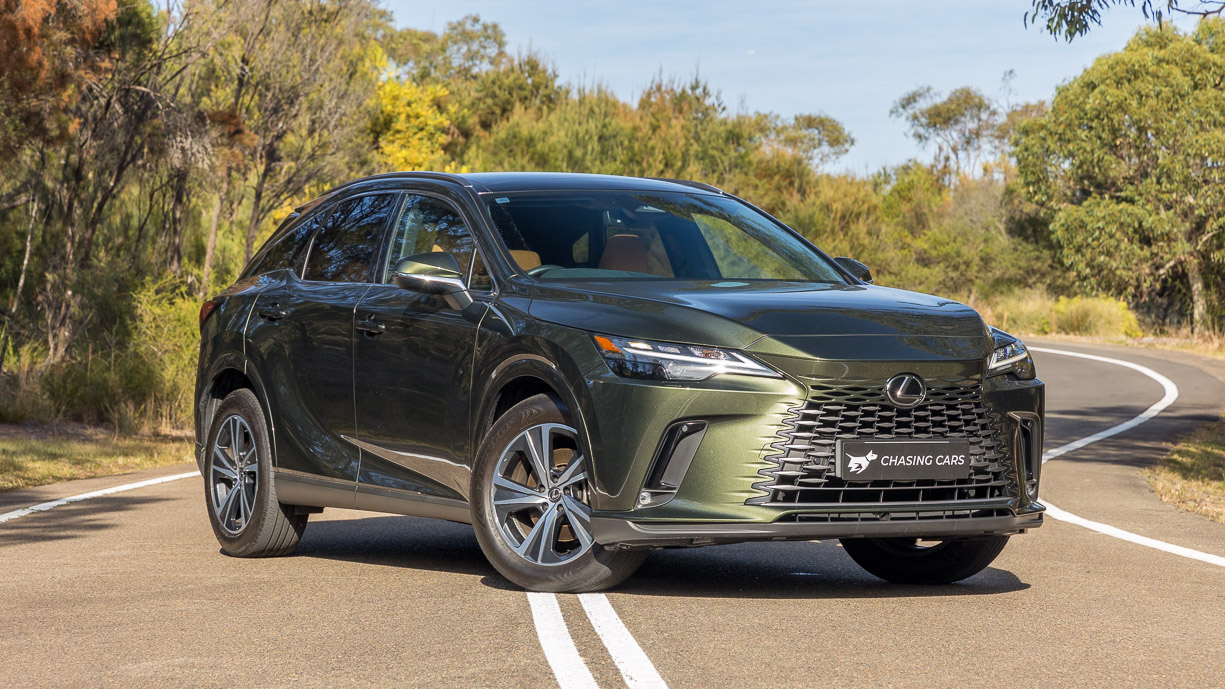
So I parked the Lexus and decided to commit auto-adultery on my Chrissy trip with another brand’s SUV…
Still, nigh on 2000km of travel in our relationship’s twilight wasn’t mucking about, what with a twin test to sneak in before what was becoming an amicable and reluctant separation between once Chief returned to its rightful Lexus Australia owner.
Would I otherwise ride off into the sunset with this RX 350h Luxury given the choice to do so? Indeed I would.
Rewind to Chief’s introduction video and I did wax lyrical about its ‘loveable pooch’ suitably to my personal taste and preferences: auto, nice ride, cracking climate control, comfy seats and quite running…in that particular order.

However, I was skeptical as to whether early romance might sour.
Let’s be frank here: I habitually spend much of my waking hours unearthing dislikes in new cars and – as I turn to yell to the nearest cloud – 2023 emphatically proved that motoring is by and large falling down a toilet of active over-nannying and annoyances becoming ever more tiresome infuriating.
Surely Chief and its new-for-2023 RX ilk would reveal themselves as caught in similarly dire straits…
But no. About a month into custodianship with Chief, I noticed something: I was increasingly compelled to reach for the Lexus key over most anything else in the Chasing Cars garage at the close of daily play, not consciously and with increasing frequency.
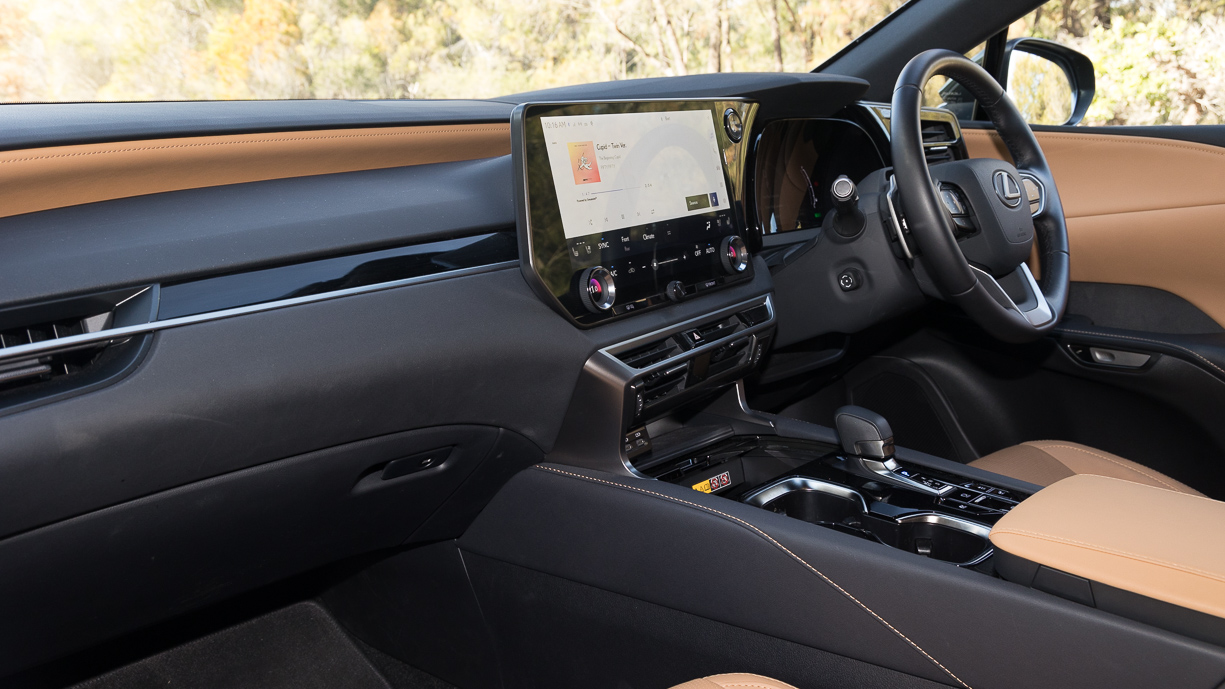
Why? Yes, the ride, the seats, the air-con – yadda yadda – though, crucially, there’s just nothing imposing, annoying or unwelcoming about it, for any trip and to any destination however near or far.
There might’ve been a few objectionable features or systems in the early days. But those that had cropped up I’d switched off and they stayed off ages ago. Permanently. And this alone won me over big time.
A premium, prestigious or luxury experience – no matter how you label it – is a feeling and essence. And it is not necessarily how thickly you trowel on complexity, digital window dressing, fussy design, material diversity or mere fanciness and trinkets for their own sake.

This is where carmakers up and down the fiscal pricing ladder often get it wrong so often. And it’s where the Lexus RX, even in entry (albeit optioned) Luxury guise, gets it right.
The Lexus RX350h Luxury isn’t perfect, but as a set-and-forget, turnkey, fuss-free rolling oasis that welcomes you at the end of an average day, one that – and here’s the crucial bit – doesn’t nag or whine at you as punishment for some inane indiscretion is the real highlight.
Room for improvement? The trim, at least in the Hazel combination, isn’t durable enough. It’s tardy with 15,000km on the clock and will look quite shabby before too long.

The switchover point when the petrol engine kicks in from pure EV drive lacks the refinement and polish befitting the rest of the package. Despite its handy blend of output and frugality, the aging Atkinson cycle tech is past its used-by date, regardless of whether buyers care or not. Add turbocharging, lose the CVT, ditch the NiMH for lithium-ion, etcetera.
The option of a larger 21-inch wheel to replace the Luxury’s 19s would be nice. This isn’t a Lexus Australia cost option and you need to step up to F Sport or Sport Luxury grades for big-wheeled effect. But I do suspect the cushy Luxury passive suspension and 21-inch blend might tune up engagement and body control a smidge to taste.
As covered off earlier, Chief’s configuration was preordained rather than chosen. Which begs: what would I now choose given free rein?

I’d be tempted by the turbo-petrol RX 350 F Sport, in Deep Blue paintwork with the Dark Rose and Aluminium interior theme, no other options required. Just in case you’re reading this, Lexus Australia…
That said, Chief’s turnkey, fuss-free satisfaction and dependable, faultless nature over its 8000km custodianship makes for a vehicle that’s easy to highly recommend. And one that, under six figures on road as a cleanskin, makes for pretty compelling value for a bona-fide luxury offering.
Let’s face it: the RX350h Luxury is something of an anchor point of its carmaker’s wider lineup, a measurable improvement in form over its forebear, and a sign that Lexus has entered a purple patch as a premium marque.
As the least-sexy choice of the RX lineup’s trio of powertrains, is the hybrid 350h befitting a six-figure luxury rig? And does it pay dividends in the ownership experience?
“How’s your handicap?” Dad jokes, eyeballing Chief, my Lexus RX 350h Luxury long-termer, for the first time.
It’s a sly barb, and not politically incorrect in intent. He’s talking golf, my Old Man insinuating that I’m the old man between us. Cute. Ironic, too, given his last beloved motoring foray was a Volkswagen Golf R wagon with Instagram-friendly aftermarket wheels…

“Been pulled over much this week?” I quip in reply.
The Old Man stigma still casts a shadow over Lexus, particularly in Australia, especially amongst – to be specific – petrolheads. At least amongst wool-dyed, old-schoolers such as Dad who, at times, can become more focused on what a car says than what a car does.
Perhaps loftier respect might’ve been more forthcoming had Chief been the spicier 350 F Sport or genuinely performance-heady 500h F Sport Performance version of the RX breed. But no. Somehow I’ve bought a veneer of shame on the family name for rocking the mildest 350h format. And from having the audacity to publicly endorse it in my longer-termer’s introduction video…
Five months into my half-year custodianship of Chief and the relationship still largely blossoms as I count the days to what’s likely an amicable and reluctant separation. Hand on heart, I’d keep riding the Lexus off into the sunset if the choice was there. Even given some reservations.

Pictured: the RX 350 F Sport
Ultimately, would I have preferred the turbo-petrol 350 or series-hybrid 500h powertrain instead of the comparatively mundane, naturally aspirated, 350h series-parallel heartbeat of Chief? At times I think so.
The 140kW 2.5-litre Atkinson cycle petrol engine central to the 350h hybrid system trades power density for efficiency by design. It’s long been a preferred cornerstone of Lexus and Toyota hybridisation, is well-developed, dependable and, frankly, at 239Nm it’s not terribly torquey nor characterful.
And just why it requires premium 95 octane is a bit of a head-scratcher…

Pictured: the RX 350 F Sport
But strap a 134kW/270Nm electric motor up front and an on-demand, by-wire 40kW/121Nm rear-axle electric motor – yielding 184kW of total system power – and we’re off the races. Even if, at 7.9 seconds claimed for the 0-100km/h, it’ll need to pull a solid Bradbury to top most podiums.
No turbocharging (like the rest of the RX lineup), one-speed CVT rather than a proper ratio-swappers (eight-speed in 350, six-speed in 500h), an older nickel-metal hydride battery rather than newer/techier lithium-ion jobbie…
It’s a workmanlike combination short on ‘oh my’ charisma and big on ‘Oh What A Feeling’ vibes.

The Lexus 350h powertrain is just…fine. It shines sometimes, a dullard at others.
The volume-selling powertrain of the RX lineup starts up in silent EV mode, likes to hang onto electric drive during most light-throttle and lower-speed duties, and faithfully proves to be frugal on the dinosaur juice, be it commuting or stretching its legs on the open road.
By how much? Umpteenth tankfuls have seen Chief pinned at an average of 6.24L/100km of pure metro/urban as-tested consumption. For stop-starting 2060kg of large luxury rig in the Big Smoke, that’s pretty decent, if a little shy of Lexus’s advertised 5.7L urban claim.
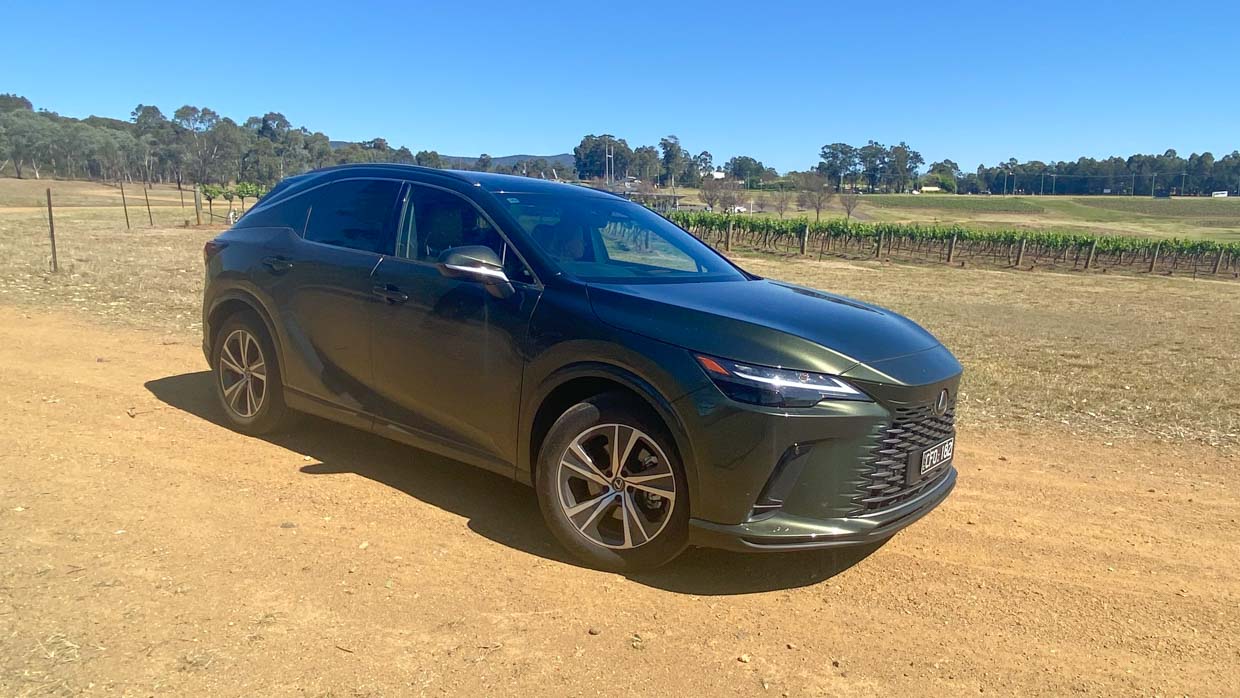
Two interstate round trips to regional Victoria from Sydney afforded four tank fills conducted purely around 110km/h cruise control driving (with a 100km/h indicated average speed). Result? A best of 6.17L and worst of 6.32L per hundred along the Hume, calculated in both directions, for a 6.245L/100km highway average. Or bang on the urban consumption figure.
For this latest RX incarnation, all-electric drive peak speed has risen from the old generation’s 68km/h to a newfound 125km/h claimed. But I’d be fibbing to suggest that I ever recalled internal combustion actually shutting shop entirely out on the highway.
Similarly, the powertrain can be forced in EV Mode in town, but given any moderate plod of the right foot kicks the 2.5 engine into life it’s largely redundant.
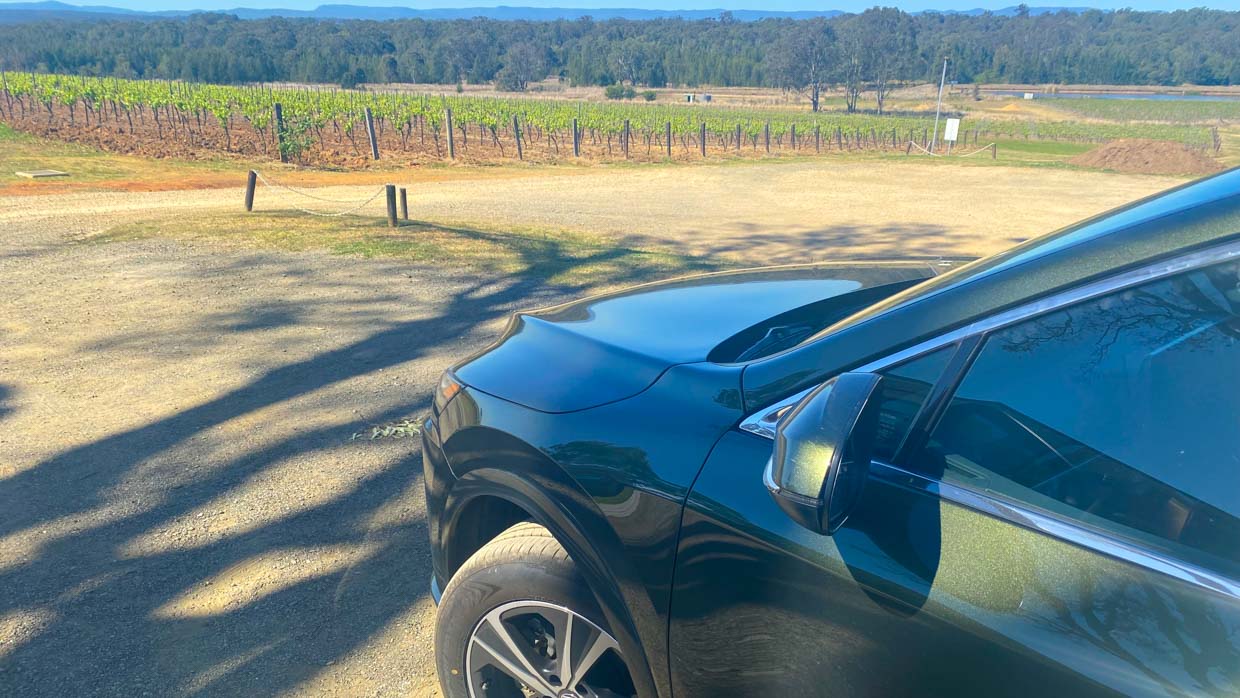
Chief gets driven exclusively in normal drive mode. In the early days, I tried eco, which was too flaccid in response, and I gave sport a whirl here and there, which is a touch too unruly and combustion-heavy for casual commuting and cruising.
So in normal mode, with its superior balance of refinement and drivability, it stayed, Chief left to its devices to sort itself out automatically. Which is just fine by yours truly.
Outright performance isn’t an issue. It remains reasonably alert, rarely gets caught wanting for more shove and, as would transpire, Chief is a damn sight quicker than its lulled character suggests.

I’ve personally performance tested all three RX powertrains since this fifth-gen RX lobbed in early 2023. The manic 273kW turbo-hybrid 500h F Sport Performance was, at 5.85sec, suitably heroic in pace. And the 205kW turbo-four-pot 350 F Sport I reviewed recently pulled a very respectable 7.12sec best for the 0-100km/h…
Then I showed Chief the starting blocks and, with sport mode activated and a 7.9sec target in the crosshairs, yanked its chain. Despite its 184kW modesty, it knocked out a 7.17sec best, or just five-hundredths shy of the turbocharged F Sport.
Right here is where I drag my soap box and address claims that some buyers don’t care two hoots about performance…until you find yourself exiting a side street from a bathroom stop on the Hume and need to plug a gap in traffic that pinned at 117km/h on cruise control while your loved ones are aboard.

The 350h certainly doesn’t make performance noises but it’s there, in its back pocket, ready to be deployed as a feature to get you and your family safely to speed. It’s there for onramps, when merging, when overtaking weaving B-doubles as well as the aforementioned side streets and it’s as effective as roadholding grip and braking capabilities in avoiding harm’s way. Chief has it in droves.
Related to this is the surety of the all-wheel-drive system. No, the 350h AWD is no off-roader, though it does offer a broken surface driveline mode that might be handy during trips to the snow fields or venturing out along our country’s many regional dirt and gravel roads.
Interestingly, the on-demand format seems proactive rather than reactive like so many other similar designs that only plies torque to the undriven axle once traction is broken on the driven axle.

Instead, according to the onboard telemetry, Chief seems to always move off the mark with torque equally spread between both axles. As the vehicle accelerates, rear axle (electric) torque drops away to presumably improve efficiency. The upshot is maximum traction on take-off regardless of the conditions or surface.
Between cellar door runs in the Hunter Valley to far-flung back roads in Victoria’s regional gold fields Chief has seen plenty of reasonably well-graded gravel and responded with ample enough balance and grip to make for comfortable and surefooted transit. No issues here.
Does the RX format really need all-paw traction given the 350h Luxury can be had as a front-driver while keeping $4500 in the hip pocket? Perhaps not.
And given my time at helm was wholly through warmer and generally drier spring and summer running, it’s tough to judge what dividends its otherwise subtle and transparent operation brings when the going gets properly slippery. But it’s a nice surety to have.

The RX certainly doesn’t need the adaptive suspension offered on higher grades. It’s always compliant, stable, and mostly unflustered by crappy Sydney urban surfaces or the unkempt Hume at cruising speeds. The passive system is well sorted and perfectly fine.
Day in and day out, Chief proved relatively harmonious companionship despite some small foibles.
Dig in and the engine rumbles into action more conspicuously than I’d like. The switchover point between full electric and hybrid drive is a little too abrupt – certainly moreso than the cleaner and more seamless – and certifiably mainstream – Hyundai Santa Fe hybrid I recently drove. It’s not quite in step with the rest of the polish of the Lexus package.
The brakes are a little too touchy at times, particularly noticeable at low speeds and, frankly, against most any other vehicle I happen to have just jumped out of. This pedal feel, though, is easy to acclimatise to with the live-in experience.

Also, at very low speed and uphill, the powertrain reveals a faint flutter that’s only very occasionally noticeable in the live-in experience. But none of these foibles are deal-breakers.
In fact, Chief’s largely fuss-free, turnkey, go-almost-anywhere friendliness is one of its big attractions. And there aren’t many places we’ve not ventured – hard-core off-roading apart – as the big Lexus and I sail into our final weeks together.
Except perhaps the golf course. Did someone shout “Fore!”…?
Beep, beep, beep, beep, beep, beep, beep, beep, beep…
I know it’s nine beeps. It’s not every time I shut down Chief – as I’ve nicknamed the big Lexus – but every other time. Or perhaps one in every three. I’ve been counting those beeps for a couple of months now, and still no wiser as to what the heck the car is trying to tell me…

It could warn that it’s unlocked. But, of course, the proximity key auto unlocks once you grab the electric door handles anyway, so there’s no way to troubleshoot.
On that, I’ve gotten accustomed to the simple elegance of the outer door lever action, and ever more tiresome in repetition of instructing newcomer occupants of how to use the inner ‘e-Latch’ door levers.
Lexus doors get more complicated. Their electric latch system brings a handy trick, called Safe Exit Assist, that defeats the latch if the blind spot sensors detect oncoming vehicles (definitely) or cyclists (presumably).

It’s great for kids not getting bowled over during hasty egress, occasionally annoying for the driver given the system’s conservative proximity tuning. But, generally, it’s a beneficial trick.
Episode 3 of my long-term marriage to Chief deserves a cabin deep dive, prefaced with the fact that, I’m happy to report, the relationship kicked off nicely and continues to blossom.
Not for any specifically tangible reasons – bar perhaps one thing – but with the genuine sense in oneself that, most days, given the choice of my long-termer and most anything else in the fast-moving musical chair game that is the Chasing Cars garage, I reach for Chief’s key.

That one thing? The RX’s seats. The designer responsible for the Lexus SUV’s pews deserves a pat on the back and a tall cold one on the house.
Eight-way adjustable with two-way power lumbar – that’s the base spec! – plus heating/ventilation, comfort access and leather accenting with our car’s optional $5500 Enhancement pack, they’re terrific. I’ve not had one passenger who hasn’t praised them.
For blending comfort and support, they make almost any alternative from any carmaker – even the Germans – feel lumpy and ill-fitting. Without intended drama or over-exhuberism, the seats are the Lexus RX’s absolute deal-maker.

Well, except the trim. As much as I do like the creme-de-la-Hazel colour, some of it, especially the right underthigh area, does not wear well, creating a dark, feathering patch on the leading edge of the seat.
Typically, fake leather – Lexus calls its stuff Nuluxe – wears well and holds colour better and for longer than dyed real stuff does.
Ordinarily, then, you’d expect seat bases to have a fake centre (for durability) and leather wings (for tactility). Lexus seems to offer the reverse, leaving the poor driver’s seat looking shaggy with barely five figures on the odometer…
Also odd is the auto heating/ventilation that, early in my custodianship, took me aback. Start dialing up a different cabin temperature via the delightful full-colour display HVAC dials – a real cabin highlight – and the system automatically heats or cools the front seats for a kind of full-bodied climate control effect, called Climate Concierge.

Frankly, I’m not much of a (ahem) fan of this situation. Nor am I into the fact that the HVAC defaults to recirculation on start-up when I favour fresh air. Result? I’m habitually turning this stuff off just after start-up, which is slightly annoying if hardly a chore.
Of course, being of Japanese origin, the displayed target temperature is about three or four degrees colder than you experience in Euro steed.
Ah, the small things you discover with a properly lived-in experience. And the things you don’t…
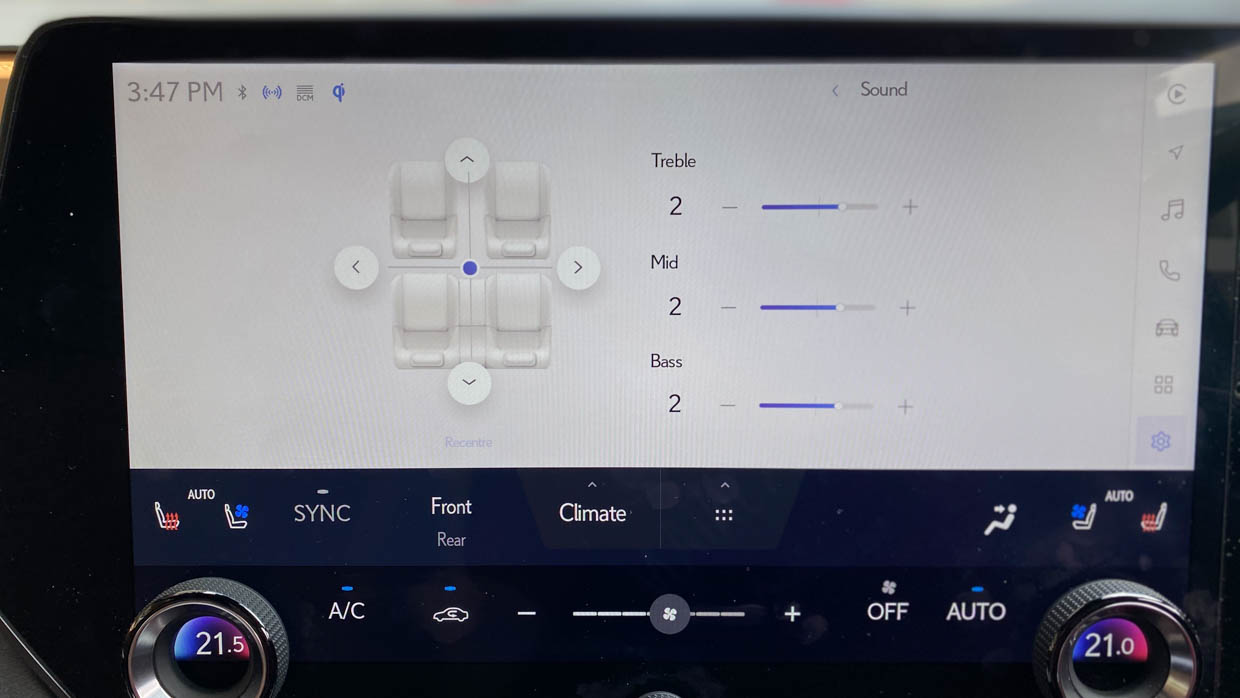
Luxury spec gets Panasonic-branded 12-speaker audio rather than the fancy Mark Levinson 21-speaker primo surround sound found further up the RX stream in variants with ‘Sport’ in their namesakes. And whomever had Chief before me, certainly liked their Panasonic bass frequencies cranked to the max.
The audio system is pretty decent – better than some of the rubbish in some premium Euro cars – but one apparently with no tone controls.
If you’re a music lover (all of Chasing Cars) or a musician (some of Chasing Cars), you’ll know poor quality or bad tone settings will park a good chunk of your favoured playlists and will force you down a podcast rabbithole.
So I dig. And dig. And dig some more. The new, whopping 14.0-inch Lexus touchscreen is two quantum leaps and a skip better than the last-gen RX – something we’ve covered off extensively since this new-gen arrived – but, frankly, there’s not a whole lot in it so not much digging to do.

There’s nothing labelled for audio tone adjustment anywhere, regardless of my persistent and periodic rechecking…
Then one day I was streaming Bluetooth audio and noticed three, small, round dots on screen. I pressed them and, hey presto, up popped the tone controls, like Indiana Jones finally unearthing the lost ark…
During the first few weeks, I did struggle with phone mirroring. I have two phones – one work, one private – and initially at least the process of swapping between the two at will was a laborious and painful sequence of submenu digging, usual while driving.

Then, after a while, it just kind of sorted itself out. The same with auto-reconnecting Apple CarPlay. My personal car space is buried underground beyond mobile reception and, for the first few weeks, Chief just flat out refused to reboot Spotify without stationary TLC. But then it just started to right itself on its own accord…
I don’t believe in ghosts in machines, but I do think that some cars like you – or want to cooperate with you – and some don’t. There’s always been a faint and subliminal undertow to Chief where, again in intangible ways, it’s got my back and it wants to look after me.
One perfect example is driver attention warning.
Let’s be frank. It does seem that, right now, there’s a sudden onslaught on the local market of Asian-produced mainstream models launched with a dramatic upswing of terribly calibrated, most certainly deal-breaking applications of driver nannying systems thinly masquerading as ‘assistance’.
Such examples include the GWM Tank 300 4×4 and even the Hyundai Kona small SUV – and there are bound to be more.

Mark these words: their negative impact on motoring normality is going to become quite large, very quickly.
Lexus, for its part, is towing the line of expanding assistance expectations. And there it sits, the Driver Monitor sensor, above the wheel horn cover staring me straight in the face.
Apparently, “should the system sense appearance and behaviours not conducive to safe driving (distracted, unusually poor posture, etcetera) then alerts and notifications are issued,” says Lexus.
Know what? I haven’t heard zip from it. Ever. The possible reasons are that a) I’m a conducively safe driver, which most new Asian vehicles have issues with or b) the Lexus system is vastly superior to anything coming out of China, Korea and Japan, or c) I’ve simply switched them off on Day One and haven’t rearmed themselves on restart. The answer is the latter.

Chief knows who’s boss. It’s got my back. This is how it should be. Happy days. A good many carmakers could and should pay attention to how Lexus deploys active safety and assistance, because the RX does it right. Mostly.
I’ve said it before and I’ll say it again: Lexus took an average seven-seat package in the old RX and created an excellent five-seater with the new one.
Unless you’re a family of sardines, a certifiably large-segment SUV with two rows of seating is the absolute way to go, for fine family or four-adult conveyance, with oodles of luggage space for most realistic needs.
I don’t spend much time in the back seat of Chief, but much like the seating almost everyone remarks about how comfy it is – and how nice it is – when they first climb in. Frankly, the RX isn’t the roomiest large SUV out there.

But it’s plenty roomy enough for every one of my friends and family thus far and the quality presentation that extends from row one through to row two undiluted does not go unnoticed.
Kudos to Lexus interior designers and how they’ve upped the RX game because, let’s not forget, this Luxury grade is the base spec. And yet, it remains a bona-fide premium luxury vibe regardless.
So you don’t get power folding/reclining rear seats, outboard heating and cooling, and sun blinds. But it doesn’t really matter what tricks you lose if you’ve got the core luxury stuff – such as proper three-zone climate control adjustment – in order because you’ll still get a prestigious result regardless. And the RX 350h Luxury proves it.
If there are any reservations about the RX interior, it’s that the Hazel trim I was so drawn to when fresh is starting to disappoint in the long burn.

Pictured: the RX 350 F Sport
And getting the opportunity to review a Cobalt Mica blue RX 350 F Sport, with its darker and more dirge-resistant ‘F Sport black’ cabin theme (and sexier 21-inch rolling stock), does begin to tug the heartstrings and drag my attention towards a different variant direction.
Which brings us neatly to how Chief drives. With its humble naturally aspirated self-charging series-parallel hybrid drive, it’s not as focused as the turbo-four AWD F Sport and not as techy and ballistic as the purely parallel turbo-hybrid F Sport Performance…both of which I’ve now reviewed independently outside of my custodianship of Chief.
We’ll see how the green machine fares on-road in the upcoming long-term update number four…
Settling into this large luxury hybrid SUV is far easier than deciding what on earth to call it.
“Bruce!” A long-termer you have to live with for half a year deserves a nickname in a way that week-loan press car loans don’t. Besides, “Lexus RX 350h Luxury AWD with Enhancement Pack” hardly rolls off the tongue.

But Bruce fails to stick after 10 minutes…and nor does Craig, Ian, Trevor or Malcolm. I then default to the obvious, but Lex (unimaginative), Rex (it’s not a dog) and Lux (it’s not soap) all falter at the start line.
I do consider Harlot, if only because my new 2023 Lexus RX arrives with 7500km on the odometer and, one imagines, plenty of other motoring scribes have had their way with it thus far. But I do imagine that this won’t amuse Lexus Australia.
I also consider the name Tom because, well, the Chasing Cars family already has three Toms, though I figure the humour in this would quickly plummet in direct response to the escalating confusion in the office…

Clearly, then, I didn’t configure this Lexus for me. But the silver lining is that, unlike some fresh-off-the-boat example, an added 10,000km to the odo gets my ‘new’ Khaki Metal green over Hazel coloured companion to a theoretical 17,500km age in the distant future and that’s some solid mileage with which to test that renowned build quality that Lexus spruiks.
But even from the get-go, I do discover that, had I configured a new Lexus RX on my terms, I’d pretty much end up with what I’d been given anyway. Khaki Metal, one of nine body colours, looks fantastic.
Within the first week, I have three different onlookers remark at its classy hue and its bubbling metallic sheen under direct sunlight.
Ditto the Hazel and Black Herringbone interior scheme, one of four offered with the Enhancement Pack of an outright available six. Honestly, I would’ve ticked that box regardless. Even if I’d argue with Lexus marketing that khaki is conventionally more tan than green, and that hazel is vice versa…

And on we go… Yes, I would’ve opted for the Luxury grade, complete with its chubby-tyred 19-inch wheel rather than the 21s fitted to, well, anything further up the RX range tree.
In theory, they ought to ride more nicely than sexier rolling stock and, given I can’t actually see the wheels while I’m driving, I’m not bothered by any aesthetic impact quite so much.
Lexus probably targets Luxury to someone such as I: 53 years young, father of three, more of a fan of nice ride, quiet running, comfy climes and leisurely pace during most drive time. I’ll happily trade frugality for the thirst of the F Sport and for the sheer pace and excess of the RX F Sport Performance.
And, frankly, it’d take some convincing that the extra $20K splurge for the Sports Luxury upgrade is worth the extra trinkets that variant brings to my table, including the adaptive variable suspension.

And let’s face it: circa $106K once parked up in my driveaway – theoretical or not – isn’t chump change. I’m really keen to assess whether the rudimentary variant feels like a serious enough proposition for what is serious enough money.
So it does get all-wheel drive – and can be had in otherwise identical form for less outlay as a front-driver – which is nice, though is it really that beneficial? I hope to find out in the coming months.
And then there’s the promised 5.4L/100km combined fuel consumption of the basic hybrid system. I’ve driven the turbo petrol 350 F Sport and was taken aback at how eagerly it shot above double figures in thirst.

Can this series-parallel 350h system, with two electric motors and on-demand rear-axle drive, prove genuinely compelling in outlay at the browser, both with urban driving where this Toyota-Lexus type of self-charging hybrid tends to pay handsome dividends, and on the open road where the benefits can be more marginal?
On that, there ought to be ample opportunity to really test the claim that the old all-electric v-max of 68km/h has been boosted significantly to 125km/h, or higher than I’m likely to see on one of the handful of interstate road trips I plan to make in the RX.
Best-case efficiency ought to reveal itself properly with ample enough seat time.

Performance? Its 7.9-second 0-100km/h claim is far quicker to assess. For the record, the green machine knocked out a best-of-three run on our test track of 7.17sec, vastly swifter than the official data.
Given that the petrol and dual-motor format boasts a combined 184kW and 391Nm of pure electric torque – not counting what undisclosed percentage of 239Nm of engine torque gets added where and when – the claimed busting seven-second pace shouldn’t be much of a surprise.
We will bury down into the new RX cabin, the tech and driving experience with time, though it is worth knocking off some quick first impressions of my new companion’s honeymoon period.
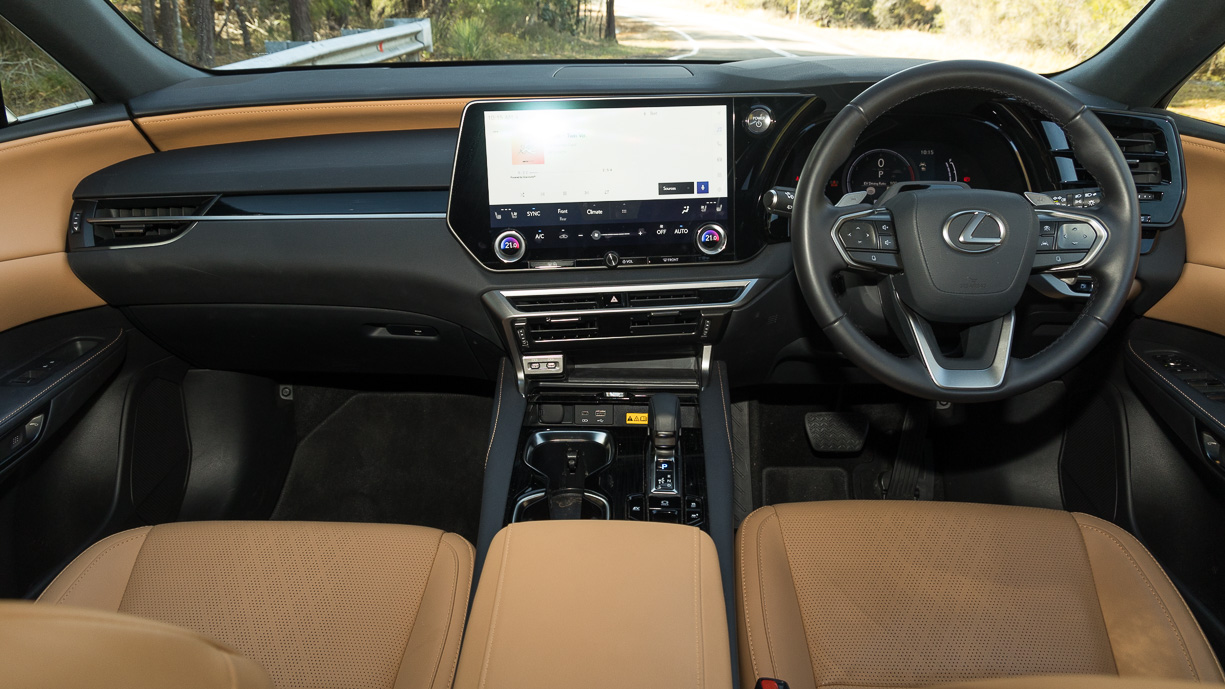
The cabin has upmarket feel-good factor that shows no sign of waning. I like the presentation, it always seems solid and welcoming and the colour scheme is an effective antidote to the grey drabness that so often greet me in most other cars I test these days.
There’s a lot of nice, tactile material choice, very little in the way of cost-conscious plastics.
I can finally stop griping about the terrible, archaic media system and the gawd-awful joystick interface of the last-gen RX.


The new 14.0-inch screen is a quantum leap forward and includes trendy “hey Lexus” voice control, though the screen smudges very quickly and easily, and some of the display information is tough to read with my dodgy old-man eyesight.
The electric door handles and latches are annoying. Not because I haven’t gotten used to them, but because I need to explain that you have to push the interior latches to exit with each and every new passenger.
The head-up display and its pairing with the touch sensitive wheel buttons is clumsy. I’m already constantly nudging the left pad (for media control in head-up) or the right pad (cruise control settings) with my thumbs as a matter of course and this is already becoming a bit of a distraction.

I’m also already concerned about some discolouration of the driver’s seat.
This is not due to personal hygiene issues I can assure you – again, it’s had 7500km of journo bum exposure to date – but that it’s slightly more tarnished than the rest of the lesser-used seating concerns me given this vehicle’s youth.
Leather cleaner? Well, I’m not exactly sure what is and isn’t real leather trim…
Then there are the nine beeps. Sometimes when you lock and leave it, the Lexus beeps once. Every other time, it’s “beep, beep, beep, beep, beep, beep, beep, beep, beep” for apparently not good reason anyone in far-flung Lexus owner forums has managed to troubleshoot. And it’s already really starting to get on my nerves.

And that’s really the key to these long-term assignments: it’s really less about the obvious goodness at play, and more about smaller compromises, challenges and annoyances that start to compound themselves over the longer-burning experience.
And so I find myself, staring at the new Lexus RX hybrid from about 10 paces, examining the doors and windows trying to figure out what it’s trying to tell me by way of nine, consecutive, increasingly grating beeps, when I notice the rego plate: CFO182 to be exact…CFO. Or, of course, chief financial officer.
I think I’m going to call my new partner in crime Chief.
The new-generation Lexus RX has all-new bodywork that’s more handsome and chiselled than before, underpinned by a shift to a lighter and wider GA-K platform that, in any of its 14 different variant guises – once you considered the various optionally available Enhancement Packs – ought to raise the quality of the breed’s ride and handling baseline.
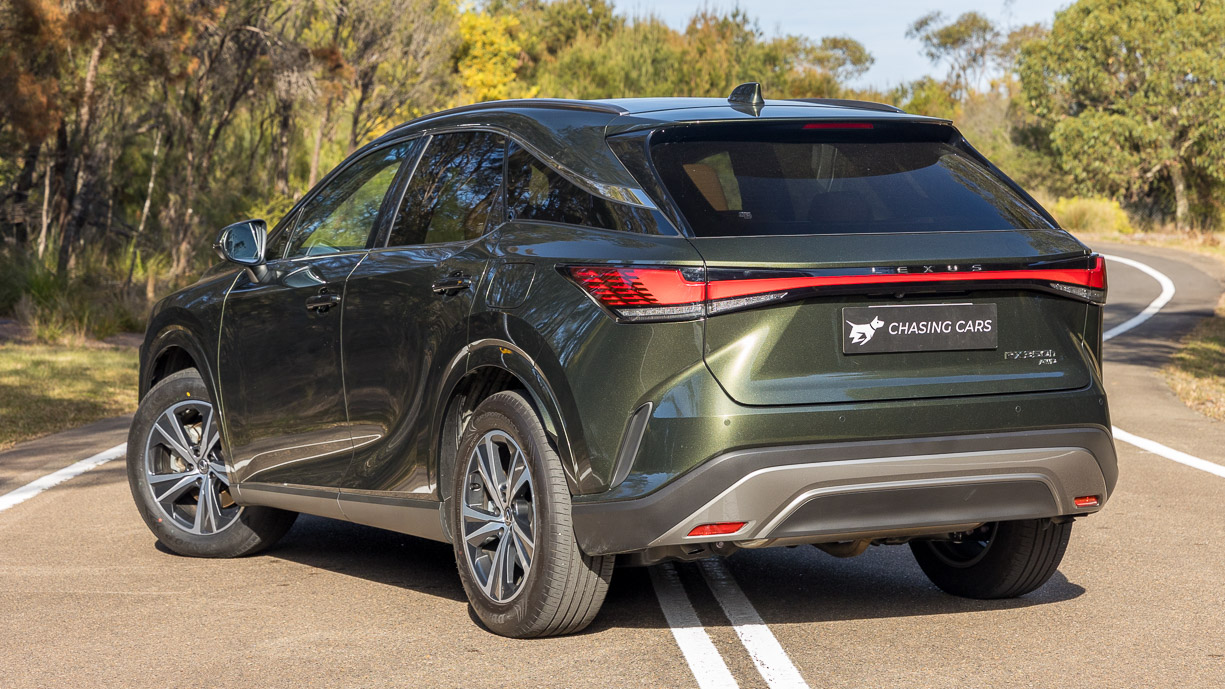
A 60mm longer wheelbase not only did wonders for the styling and proportions of the new 2023 Lexus RX range but also facilitated extra interior space compounded in no small measure by the fact that new Lexus RX range is no longer offered a three-row option and was now only available as a five seater.
The seven-seat role has now more permanently been taken up by the new US-market TX large SUV, with no plans to come to Australia. Currently, the Toyota Land Cruiser 300 Series-based LX is the only three-row solution offered locally.
The big changes to the new-gen RX didn’t stop there. With the same technical migration seen across the wider Toyota landscape, the Lexus RX ditched to passé petrol V6 engines in favour of 2.4-litre turbocharged power units for two of three of the new powertrain choices.

First up, a 2.4-litre turbo four is reserved for the 350 F Sport, complete with eight-speed auto and mechanical all-wheel drive.
Then there’s the flagship format that marries a similar (though not identical) 2.4L unit with two electric motors for a complex, Lexus-first parallel-only hybrid system with all-wheel drive for the RX 500h F Sport Performance tree-topper.
Positioned as the third and somewhat staple choice for the lion’s share of buyers is the 350h hybrid choice, blending 2.5-litre four cylinder and CVT drive with either one electric-motor (front-mounted) or two electric-motor (front and rear axles for all-wheel drive) series-parallel powertrains.
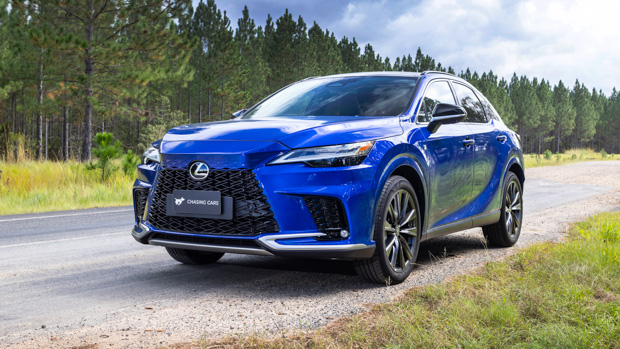
Pictured: the RX 350 F Sport
The Lexus RX grade walk was largely carryover: the Luxury as RX at its most basic; the Sports Luxury the pricier option with more bourgeoise features set and the F Sport, with its unique powertrain spec.
However at the top of the tree now stood the singular sporty focussed choice; and the all-you-can-eat RX 500h F Sport Performance marking its namesake territory with sheer space and the technical unorthodoxy of its hybrid powertrain and all-wheel-drive system.
Interiors, too, were dragged out of the fourth-generation dark ages with more contemporary tech and a stylish new design creating roomier accommodation from the slimmer two-row cabin format.

Pictured: the RX 500h F Sport Performance
Much like the rest of the Lexus RX package, first impressions were of a noticeably fresher RX spin without necessarily abandoning too many classic stylisms and flourishes that appeal to traditionalist Lexus devotees.
What did we think? Of the others in the Lexus RX range, the top dog RX 500h F Sport Performance scored 8.5/10 at our international first drive, while the volume-targeting 350 h Luxury rated at 7.5/10 in Aussie spec at the range’s local launch in February 2023.
The pure-ICE 350 F Sport also scored 7.5/10 once it rolled through the Chasing Cars garage for a longer, week-long stint.

Now, the RX 350h Luxury AWD with Enhancement Pack ambles into the Chasing Cars stable and into the custodianship of Deputy Editor Curt Dupriez for six months and 10,000kms.
So, why is it here?
To decode nomenclature, our new long-termer is the petrol hybrid (RX 350h) base spec (Luxury) with a higher-grade driveline choice of the two available (AWD) that’s augmented with some extra niceties and creature comforts (Enhancement Pack).
It’s a good spec to review, affording the opportunity to sample the Lexus RX in a base format (from $87,500 before on road costs) if with the chance to assess whether AWD (+4500) brings much to the ownership table.

We’ll also be asking whether there’s merit to the extra splurge for the Enhancement Pack (+$5500) fitout that amounts to a $10K premium above the entry 350h Luxury FWD and four steps up the 14-rung RX tree.
This is really where the majority of potential new RX owners will shop and the key options – AWD and Premium Pack – they’re likely to consider, not including the choice of premium paint (+1750).
The MY23 Luxury grade includes:

Unlike the adaptive variable suspension fitted further up the range, the Luxury fits passive dampers.
The optional Enhancement Pack adds:

Lexus safety features of this grade of Lexus RX hybrid fits:
Outlay? The new RX 350h Luxury AWD is priced at $92,000 before on-road costs with the Enhancement Pack ($5500) and Khaki Metal metallic paint ($1750) lifting pricing before on-roads to $99,250.
According to the Lexus online configurator at the time of writing, our long-termer would command a touch under $107K driveaway.
Key specs (as tested)
About Chasing cars
Chasing Cars reviews are 100% independent.
Because we are powered by Budget Direct Insurance, we don’t receive advertising or sales revenue from car manufacturers.
We’re truly independent – giving you Australia’s best car reviews.
The estimate provided does not take into account your personal circumstances but is intended to give a general indication of the cost of insurance, in order to obtain a complete quote, please visit www.budgetdirect.com.au. Estimate includes 15%^ online discount.
^Conditions Apply
Budget Direct Insurance arranged by Auto & General Services Pty Ltd ACN 003 617 909(AGS) AFSL 241 411, for and on behalf of the insurer, Auto & General Insurance Company Limited(ABN 42 111 586 353, AFSL 285 571).Because we don’t know your financial needs, we can’t advise you if this insurance will suit you. You should consider your needs and the Product Disclosure Statement before making a decision to buy insurance. Terms and conditions apply.
Indicative quote based on assumptions including postcode , 40 year old male with no offences, licence suspensions or claims in the last 5 years, a NCD Rating 1 and no younger drivers listed. White car, driven up to 10,000kms a year, unfinanced, with no modifications, factory options and/or non-standard accessories, private use only and garaged at night.
^Online Discounts Terms & Conditions
1. Discounts apply to the premium paid for a new Budget Direct Gold Comprehensive Car Insurance, Third Party Property Only or Third Party Property, Fire & Theft Insurance policy initiated online on or after 29 March 2017. Discounts do not apply to optional Roadside Assistance.
2. Discounts do not apply to any renewal offer of insurance.
3. Discounts only apply to the insurance portion of the premium. Discounts are applied before government charges, taxes, levies and fees, including instalment processing fees (as applicable). The full extent of discounts may therefore be impacted.
4. We reserve the right to change the offer without notice.